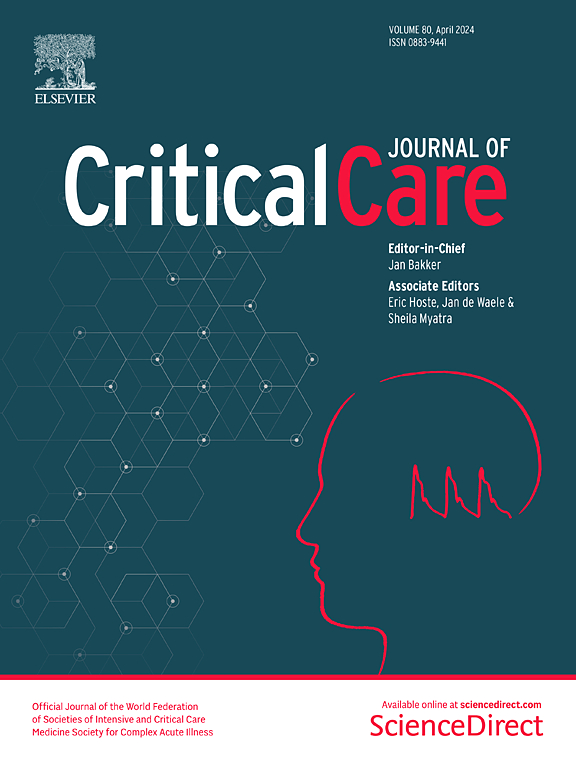基于最佳电阻抗断层扫描的急性呼吸窘迫综合征(ARDS)患者静脉-静脉ECMO的PEEP和招募-膨胀比
IF 8.8
1区 医学
Q1 CRITICAL CARE MEDICINE
引用次数: 0
摘要
在静脉-静脉ECMO超保护性肺通气患者中,招募与充气(R/I)比在识别PEEP招募者中的意义尚未得到很好的证实。比较R/I比和电阻抗断层扫描(EIT)在确定ECMO和极低潮气量通气的重症ARDS患者最佳PEEP设置中的一致性。最初,进行低流量充气以检测和测量气道开口压力(AOP)。随后,从PEEP 15-5 cmH2O计算R/I比率,然后进行递减PEEP试验(在2个cmH2O步骤中20-6 cmH2O),由EIT监测。基于eit的最佳PEEP定义为塌陷曲线和过胀曲线的交集。54例ECMO患者(潮气量:4.8 [3.0-6.0]mL/kg)中,13例(24%)的气道开放压力(AOP)为11 (8-14)cmH2O。该队列的中位R/I比率为0.43(0.28-0.61)。基于三级元的R/I比分析(≤0.34;0.34-0.54; > 0.54)显示,基于eit的中位最佳PEEP分别为8[8 - 10]、10[8 - 14]和14 [12-16]cmH2O。EIT测量的R/I比值与肺过度扩张呈弱负相关(R2 = 0.19),与肺塌陷呈正相关(R2 = 0.26) (p = 0.34),这有助于识别可能从EIT进一步个体化PEEP优化中获益的患者。相反,当R/I比≤0.34时,适度的PEEP水平(8-10 cmH₂O)就足够了。本文章由计算机程序翻译,如有差异,请以英文原文为准。
Optimum electrical impedance tomography-based PEEP and recruitment-to-inflation ratio in patients with severe ARDS on venovenous ECMO
The significance of the Recruitment to Inflation (R/I) ratio in identifying PEEP recruiters in patients undergoing ultra-protective lung ventilation during venovenous ECMO is not well established. To compare the concordance of the R/I ratio and Electrical Impedance Tomography (EIT) in determining optimum PEEP settings in severe ARDS patients on ECMO and ventilated with very low tidal volumes. Initially, a low-flow insufflation was performed to detect and measure the airway opening pressure (AOP). Subsequently, the R/I ratio was calculated from PEEP 15–5 cmH2O, followed by a decremental PEEP trial (20–6 cmH2O in 2 cmH2O steps) monitored by EIT. The optimum EIT-based PEEP was defined as the intersection of the collapse and overdistension curves. Among 54 ECMO patients (tidal volume: 4.8 [3.0–6.0] mL/kg), 13 (24%) exhibited an airway opening pressure (AOP) of 11 (8–14) cmH2O. The cohort’s median R/I ratio was 0.43 (0.28–0.61). A tertile-based analysis of the R/I ratio (≤ 0.34; 0.34–0.54; > 0.54) revealed median optimum EIT-based PEEP of 8 [8–10], 10 [8–14], and 14 [12–16] cmH2O, respectively. The R/I ratio demonstrated weak inverse correlations with lung overdistension (R2 = 0.19) and positive correlations with lung collapse (R2 = 0.26) measured by EIT (p < 0.01). The R/I ratio is feasible during ultra-protective ventilation and provides valuable indications for guiding PEEP titration. Specifically, an R/I ratio > 0.34 may help identify patients likely to benefit from further individualized PEEP optimization using EIT. In contrast, when the R/I ratio is ≤ 0.34, a moderate PEEP level (8–10 cmH₂O) may suffice.
求助全文
通过发布文献求助,成功后即可免费获取论文全文。
去求助
来源期刊

Critical Care
医学-危重病医学
CiteScore
20.60
自引率
3.30%
发文量
348
审稿时长
1.5 months
期刊介绍:
Critical Care is an esteemed international medical journal that undergoes a rigorous peer-review process to maintain its high quality standards. Its primary objective is to enhance the healthcare services offered to critically ill patients. To achieve this, the journal focuses on gathering, exchanging, disseminating, and endorsing evidence-based information that is highly relevant to intensivists. By doing so, Critical Care seeks to provide a thorough and inclusive examination of the intensive care field.
 求助内容:
求助内容: 应助结果提醒方式:
应助结果提醒方式:


